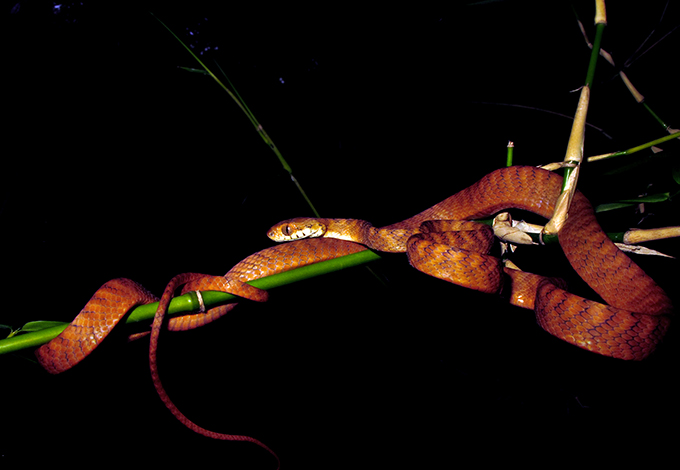Superregnum: Eukaryota
Regnum: Animalia
Subregnum: Eumetazoa
Cladus: Bilateria
Cladus: Nephrozoa
Superphylum: Deuterostomia
Phylum: Chordata
Cladus: Craniata
Subphylum: Vertebrata
Infraphylum: Gnathostomata
Superclassis: Tetrapoda
Cladus: Reptiliomorpha
Cladus: Amniota
Classis: Reptilia
Cladus: Eureptilia
Cladus: Romeriida
Subclassis: Diapsida
Cladus: Sauria
Infraclassis: Lepidosauromorpha
Superordo: Lepidosauria
Ordo: Squamata
Subordo: Serpentes
Infraordo: Caenophidia
Superfamilia: Colubroidea
Familia: Colubridae
Subfamilia: Colubrinae
Genus: Boiga
Species: Boiga andamanensis
Name
Boiga andamanensis (Wall, 1909)
Type locality: Andaman Islands.
Synonyms
Dipsadomorphus andamanensis Wall, 1909
Boiga andamanensis — Das, 1996: 54
Boiga andamanensis — Whitaker & Captain, 2004
References
Wall, F., 1909. Remarks on some forms of Dipsadomorphus. Rec. Ind. Mus. 3: 151–155.
Orlov, Nikolai L. and Sergei A. Ryabov, 2002. A new species of the genus Boiga (Serpentes, Colubridae, Colubrinae) from Tanahjampea Island and description of "black form" of Boiga cynodon Complex from Sumatra (Indonesia). Russ. J. Herpetol. 9(1): 33–56.
Whitaker, Romulus and Ashok Captain, 2004. Snakes of India. Draco Books, 500 pp.
Boiga andamanensis at the New Reptile Database. Accessed on 20 August 2008.
Vernacular names
English: Andaman Cat Snake
Boiga andamanensis, known commonly as the Andaman cat snake, is a species of rear-fanged mildly venomous snake in the family Colubridae. The species is endemic to the Andaman Islands.
Description
The body of B. andamanensis is long, thin, and laterally compressed, with smooth dorsal scales. The head is distinctly broader than the neck. The eye is large, and has a vertical pupil. The tail is long. Dorsally, the Andaman cat snake is pale reddish or greyish brown, uniform, or with a series of dark brown vertebral spots or thin cross-lines. There is dark colour usually on the scale edges. The markings are most distinct on the forebody. The top of the head has faint, dark brown or black lines. The upper lip scales are white, the last few with thin black rear edges. There is an indistinct black line from behind the eye to the angle of the mouth. The underside of the body is white or yellowish, usually with a series of black spots on each side. Juveniles and sub-adults are similarly patterned, and usually dark orange above, paler below. Most of the scales on the top of the head vary in shape and size, and are distinctly larger than the dorsal scales. The average adult total length (including tail) is approximately 0.85 metres (2.8 ft),[2] but it may grow to a total length of 1.49 metres (4.9 ft).[3]
Scalation
Dorsal scales in 21:21:15 oblique rows, smooth; vertebral scales distinctly enlarged. Ventrals 255–269, strongly angulate laterally; anal entire; subcaudals 118–133, paired. Loreal 1; preocular 1, reaches upper surface of head, often touches frontal; postoculars 2, rarely 3; temporals 3+3 or 3+4; supralabials 8 (3rd to 5th touching eye).
Geographic range
B. andamanensis is endemic to the Andaman islands of India.[3]
Habitat
The Andaman cat snake is a forest species and is also frequently found in thatched roofs of houses.[3]
Behaviour and ecology
B. andamanensis is nocturnal and arboreal. It is occasionally seen on the ground searching for prey. It generally has a mild disposition but has been observed to strike when approached. If provoked it will raise its forebody, coil into loops, often vibrating its tail, and bite readily. It is a rear-fanged snake and has a mild venom which can paralyze small prey.[3] It preys mainly on geckos, other small lizards (especially lizards of the genus Calotes), and rodents, but will occasionally eat tree frogs and bats.[2]
References
Uetz, Peter. "Boiga andamanensis (WALL, 1909)". The Reptile Database. www.reptile-database.org. Retrieved 16 April 2012.
"Boiga andamanensis ". Clinical Toxinology Resource. University of Adelaide. Retrieved 16 April 2012.
Whitaker R, Captain A (2007). Snakes of India: The Field Guide. Chennai: Draco Books. p. 290. ISBN 81-901873-0-9.
Further reading
Das I (2002). A Photographic Guide to Snakes and other Reptiles of India. Sanibel Island, Florida: Ralph Curtis Books. 144 pp. ISBN 0-88359-056-5. (Boiga andamanensis, p. 21).
Wall F (1909). "Remarks on some forms of Dipsadomorphus ". Records of the Indian Museum 3: 151–155. (Dipsadomorphus andamanensis, new species, pp. 153–154).
Retrieved from "http://en.wikipedia.org/"
All text is available under the terms of the GNU Free Documentation License


